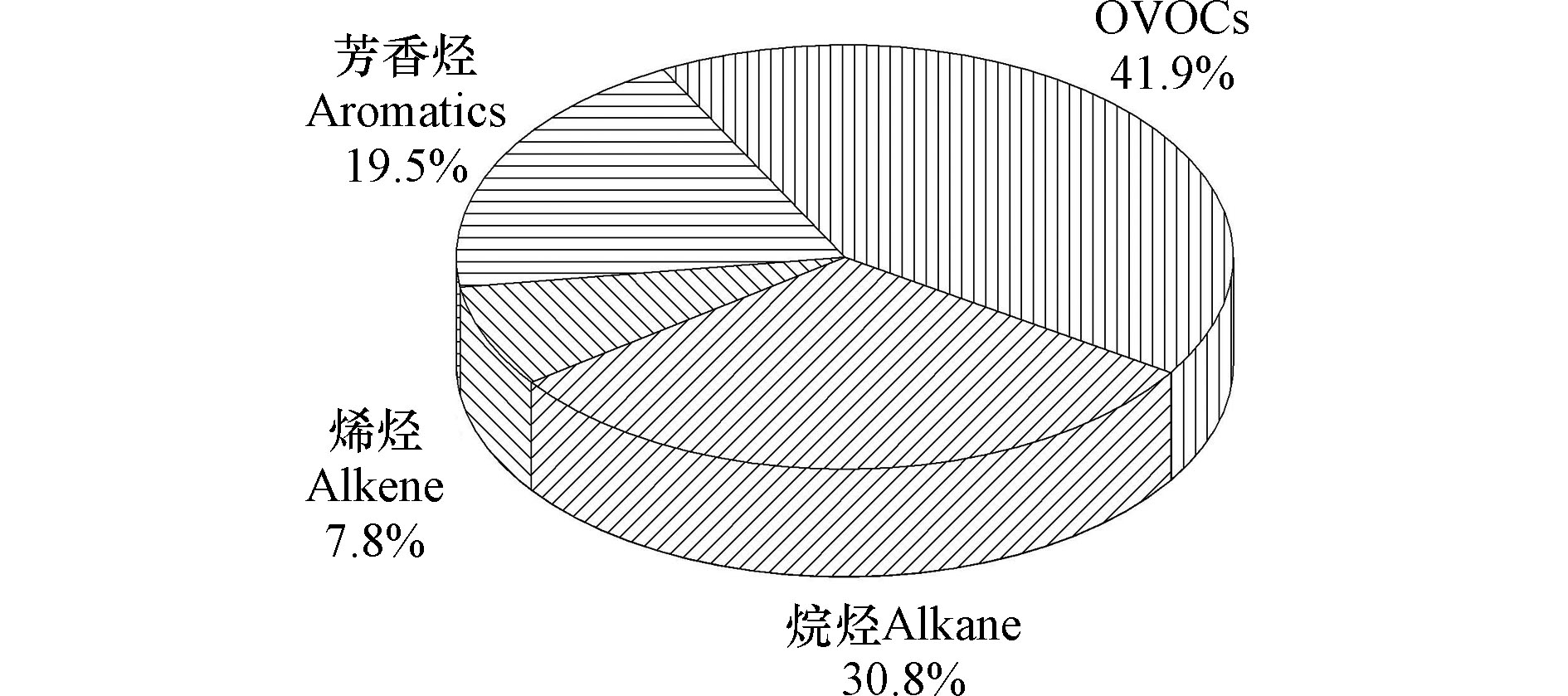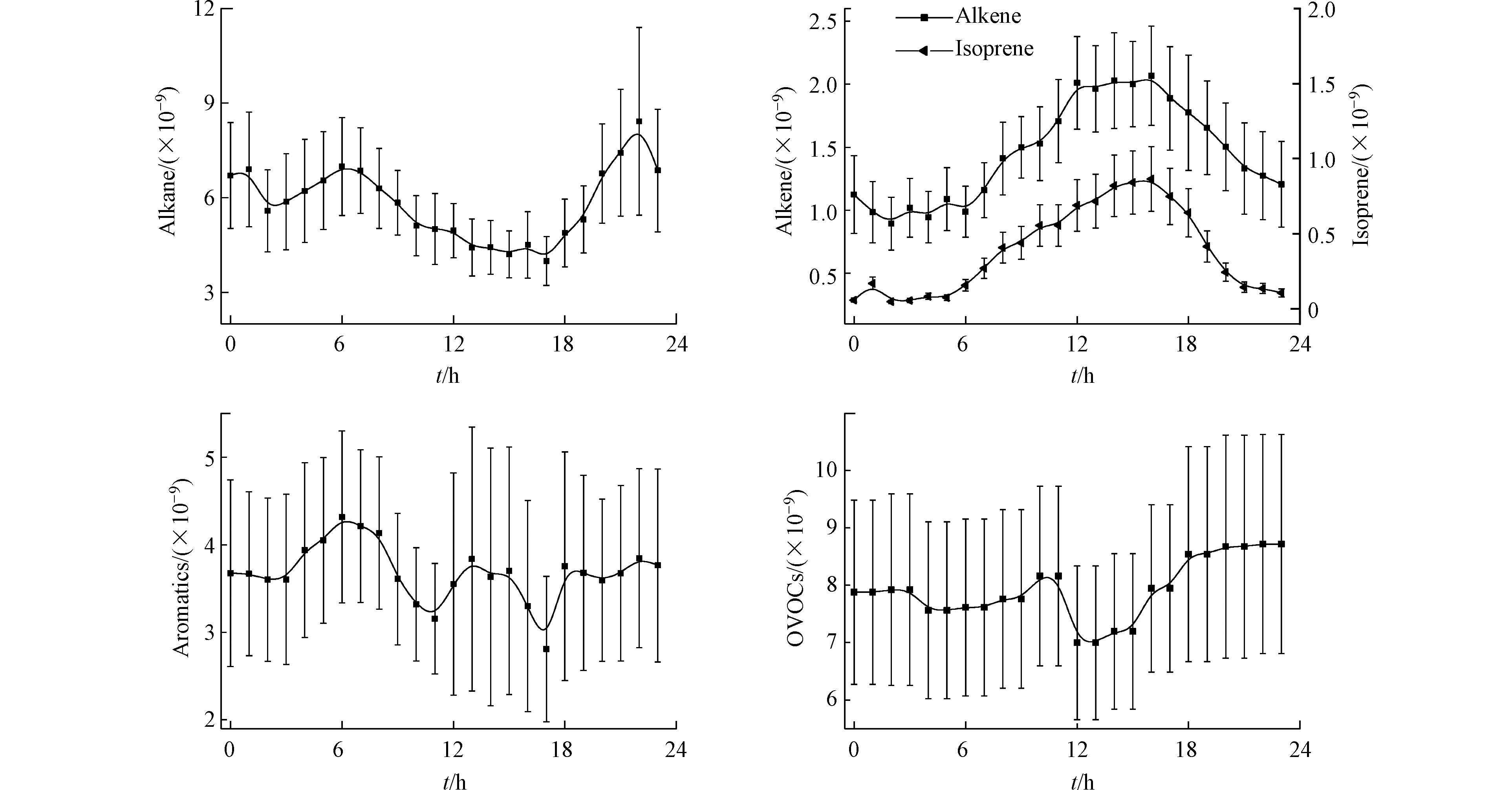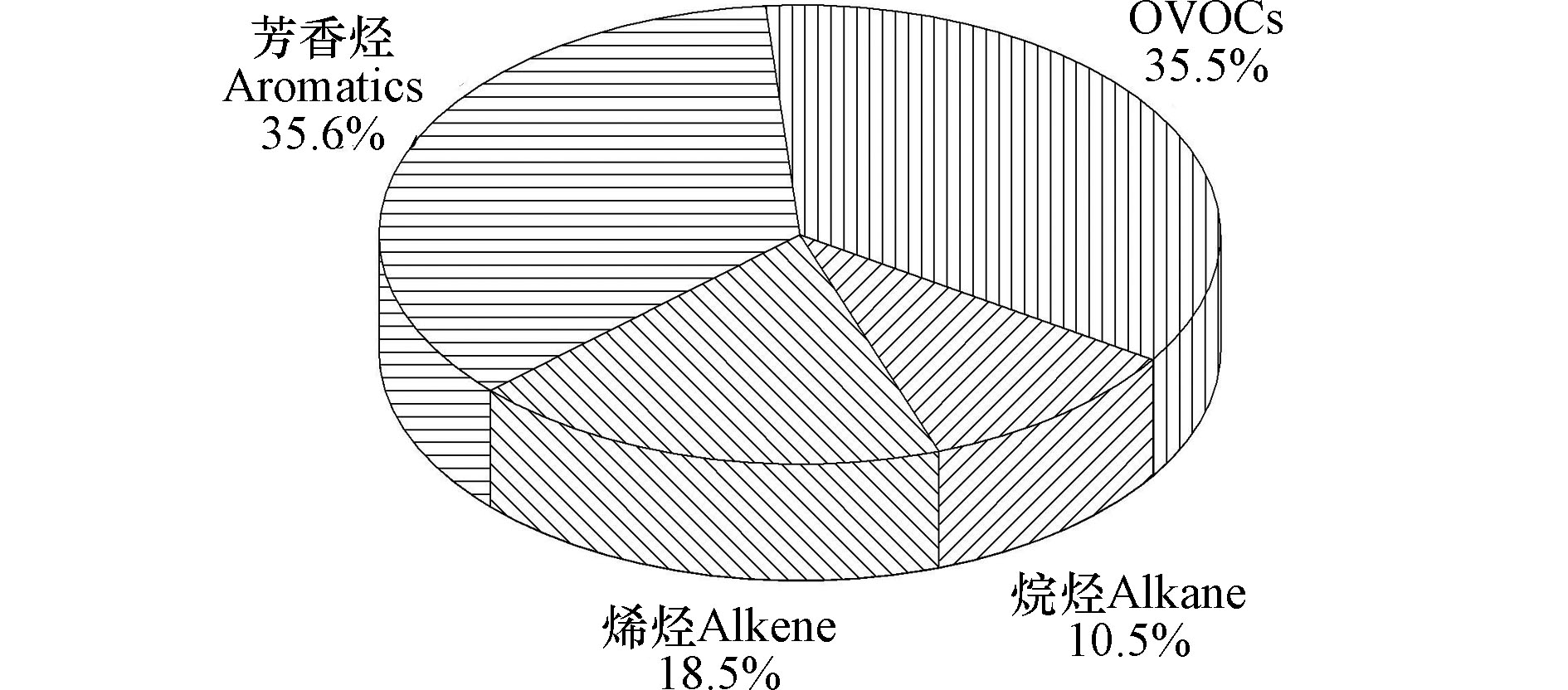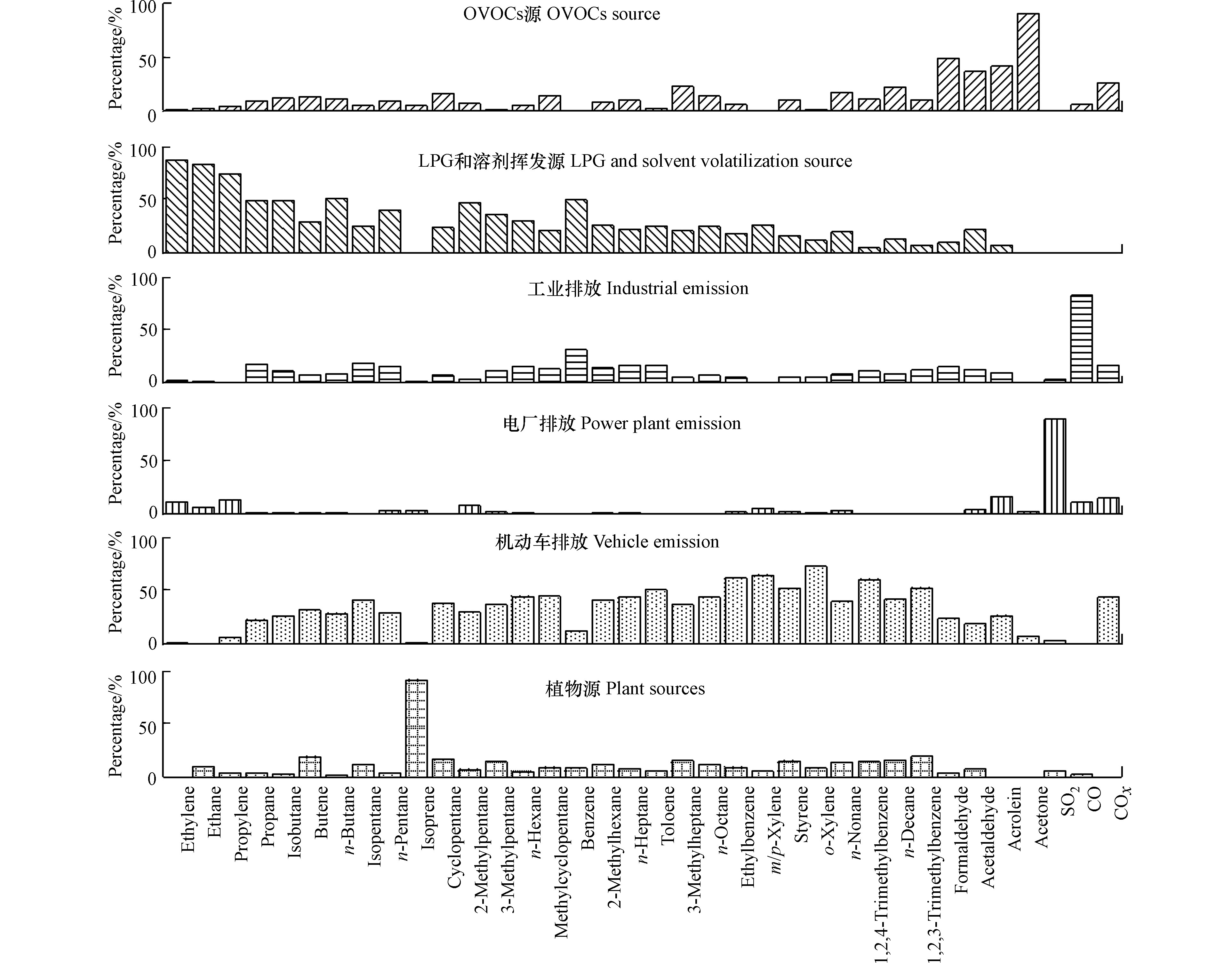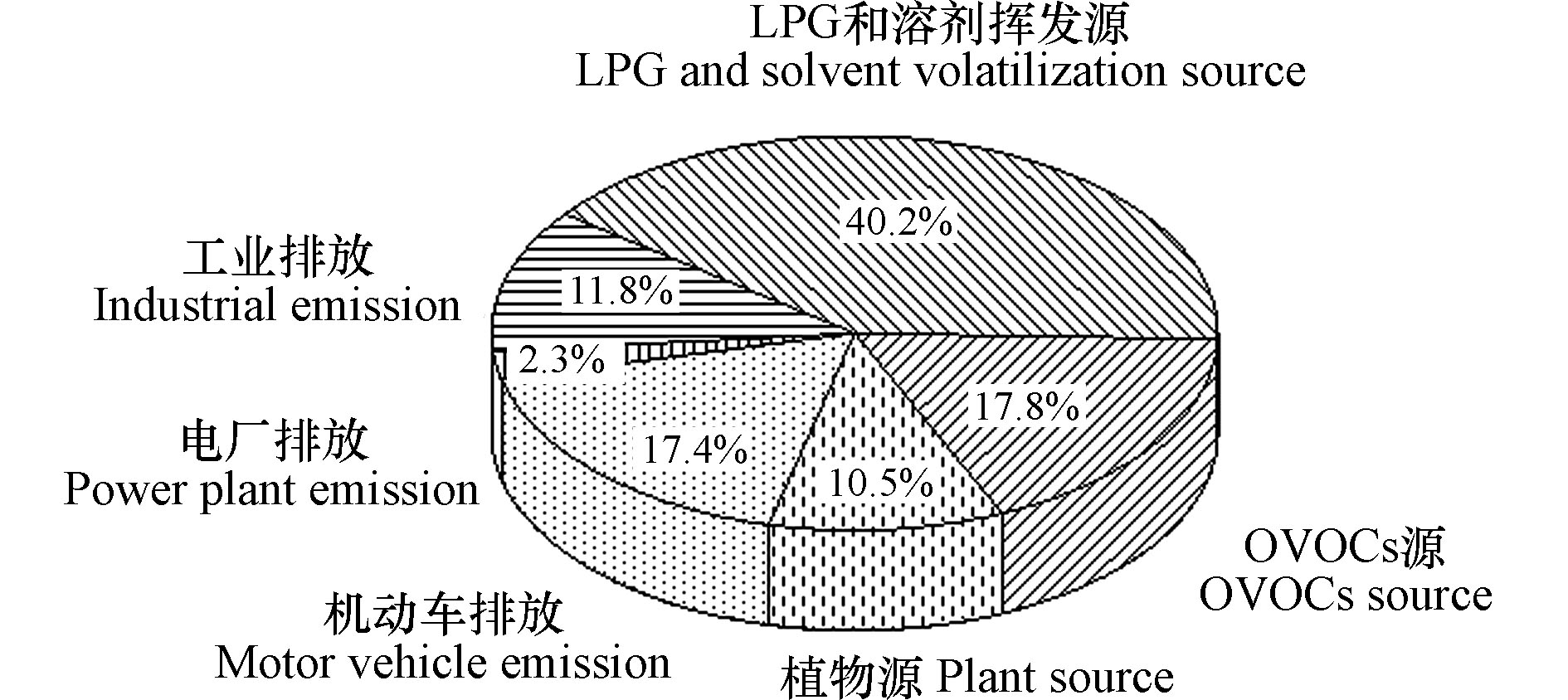-
近几年,臭氧(O3)已成为影响我国环境空气质量的重要因素,其中京津冀及周边地区、长三角地区以O3为首要污染物的超标天数占比已经超过PM2.5[1-3]。研究表明,挥发性有机物(VOCs)可在紫外线照射下与氮氧化物(NOx)发生光化学反应,产生光化学烟雾,光化学烟雾的主要成分为O3[4-5]。因此,作为O3重要前体物的VOCs到研究学者的广泛关注。
VOCs种类繁多,不同种类的VOCs化学反应活性也不相同,研究VOCs的组成和来源特征对控制O3污染和揭示复合型大气污染的形成都具有重要意义[6]。目前国内关于VOCs的监测和研究主要集中在长江三角洲[7-8]、珠江三角洲[9-10]和京津冀[11-12]等地区。山东半岛相关的研究较少,刘泽常等[13]研究表明,济南市区VOCs的优势组分为C3—C5的烷烃、丙烯、顺-2-丁烯、间/对二甲苯和甲苯等,主要来源为汽车尾气、工业源和燃烧源。薛莲等[14]发现青岛市大气VOCs中烯烃对臭氧的生成贡献远高于烷烃和芳香烃。张桢超[15]发现威海市大气中,C2—C4烯烃类、烷烃类和苯系物对臭氧的生成贡献率较高,VOCs主要来源于机动车排放、工艺过程和溶剂使用。
泰安市地处山东省中部的泰山南麓,三面环山,属于内陆中小型城市。2016—2017年,泰安市O3最大8 h平均浓度分别为197 μg·m−3和210 μg·m−3,在全省分别排名第二位和第一位。臭氧已成为泰安市夏、秋季节环境空气的首要污染物[16]。了解臭氧前体物VOCs的污染现状及来源对泰安市采取适当措施改善空气质量具有重要意义。
本研究在泰安市城区建立一个观测站点,采用在线观测法,连续对站点大气中的VOCs进行监测,分析其浓度特征,并利用特征比值和模型分析对VOCs进行来源解析,同时评估其臭氧生成潜势,以期为泰安市大气环境VOCs和O3污染管控提供科学支撑。
-
本次观测时间为2018年6月1日—7月11日,可以反应泰安市夏季大气中VOCs的污染特点。监测地点位于泰安市泰山区的山东电力高等专科学校校院内(36.18°N,117.11°E),该观测点是泰安市的国控监测点,周边紧邻交通干线,同时分布着农贸市场、工业区、商业区和居民区,是典型的城市中心站点,观测点位置如图1所示。
NMHCs的观测采用由中国科学院生态环境研究中心自主研发的GC-FID-VOCs在线监测仪24 h连续监测,采样时间分辨率为1 h,毛细管色谱柱型号为OV-1(30 m 柱长× 0.32 mm直径 × 1.0 μm厚度);采样时,通过采样泵以50 mL·min−1的流速将环境气体浓缩至温度为−80 ℃的吸附管中,然后升温加热至100 ℃进行热脱附,保持6 min;同时以5 mL·min−1的N2流速将解吸的样品吹入GC毛细管色谱柱中进行分离,此时将吸附管的温度升高至220 ℃,以60 mL·min−1反吹10 min以清除残留;色谱柱的程序升温如下:初始温度为−60 ℃,保持3 min;以12 ℃·min−1升温至−20 ℃;以6 ℃·min−1升温至30 ℃;以10 ℃·min−1升温至170 ℃,保持2 min;FID检测器的温度为250 ℃,仪器共检测到51种物质,其中包含27种烷烃、9种烯烃和15种芳香烃[16]。醛酮类化合物(OVOCs)的观测采用涂有2,4-二硝基苯肼(DNPH)衍生化试剂的硅胶小柱采集,每2 h采集1个样品,并采用高效液相色谱(HPLC)方法检测,共检测出15种OVOCs。
为了保证观测数据的有效性和可靠性,GC-FID-VOCs在线监测仪每2 d采用美国环保署认可的Linde SPECTRA Environmental Gases标准气体进行5点校准,校准时相关系数均在0.992—0.995;同时,为了避免一些高反应性的VOCs物种的氧化损失,在采样吸附管的前端连接填充亚硫酸钠的捕集器,用于去除空气中的氧化剂,每2 d更换1次亚硫酸钠捕集器;高效液相色谱每2 d进行曲线校准,每20个样品分析一次校准曲线中间浓度点,每个目标化合物的测定结果与初始浓度值相对偏差≤30%[16-17]。除VOCs的观测外,同时观测环境空气中的CO、SO2和NOx等参数,监测仪器均采用赛默飞世尔科技公司i系列的自动连续检测仪。
-
不同城市中大气VOCs的来源各异,VOCs中各组分的浓度水平和化学活性也不同,对大气O3生成的贡献也有差异。臭氧生成潜势(OFP)是用最大增量反应活性方法评估挥发性有机化合物的光化学反应性,并估算臭氧形成过程中单个有机化合物的贡献率[18],计算公式为:
式中,OFPi为第i个VOCs物种的臭氧生成潜势,μg·m−3;[VOCsi]表示物种i的环境质量浓度,μg·m−3;MIRi为VOCs第i个物种最大增量反应中臭氧生成系数,可在文献[19]中查出。
-
正交矩阵因子分析模型(positive matrix factorization,PMF)作为受体模型,根据长时间序列的受体化学组分数据集进行VOCs来源解析[20]。PMF计算过程中的基本公式为:
式中,Xij为样本i中污染物j的浓度,×10−9;p表示污染源的数量;gik为第k个来源对第i个因子的贡献量,%;fkj为第k个源中第j个组分的分布占比,%;eij为样本残差。PMF模型主要是将目标函数Q最小化[21-22],目标函数Q定义为:
式中,n为样本个数,m为物种个数;uij表示样本中物种的不确定性。根据PMF5.0指导方法要求,不确定度的计算公式为:
式中,unc. 表示样本中物种的不确定度;C表示样本中物种的浓度;RSD表示相对标准偏差;MDL表示检出限。
-
观测期间采样频率为1 h,VOCs浓度平均值为(16.57±7.99)×10−9(体积分数)。由表1可知,观测期间VOCs浓度水平最高的物种是甲醛(3.18±2.09)×10−9和丙酮(2.02±1.27)×10−9,其次为丙烷(1.71±1.41)×10−9、乙醛(1.39±0.61)×10−9和丁烷(0.92±0.88)×10−9。由图2可以看出,整个监测期间VOCs四大组分浓度顺序依次为:OVOCs(41.9%)> 烷烃(30.8%)> 芳香烃(19.5%) > 烯烃(7.8%)。
由于VOCs来源的不同和化学活性的差异,导致VOCs组分浓度的日变化特征也不同,分析VOCs浓度日变化特征是探讨其来源的重要手段之一。图3给出了观测站点大气中烷烃、烯烃、芳香烃和OVOCs的日变化趋势。烷烃、芳香烃和OVOCs日变化趋势较为一致,整体呈现夜间高白天低的变化特征;因为早晚存在较强的人类活动,如城市地区机动车尾气排放等,同时早晚大气较稳定,不利于VOCs的扩散;中午及下午对流强,边界层抬升,有利于污染物的扩散,同时中午和下午太阳辐射强,大气光化学反应活性剧烈,也会消耗一定量的VOCs,造成大气中VOCs的浓度下降。然而,烯烃在白天出现了显著抬升的变化特征,这主要是来自于植物活动排放异戊二烯的重要贡献[23-24],在白天随着太阳辐射的增强,异戊二烯排放量明显增加,在午后达到峰值,16:00以后由于植物活性等影响,其浓度快速下降。
对于烷烃,由于观测站点靠近蔬菜批发市场,运输车辆工作较早,受交通早高峰影响,在06:00出现峰值,随后太阳辐射增强,光化学反应消耗增加,浓度逐渐降低,在17:00以后,光化学反应消耗停止并随着市内交通晚高峰到来,污染物的浓度逐渐积累。芳香烃和OVOCs相对于烷烃和烯烃峰型规律没那么明显,芳香烃在中午出现了浓度升高的趋势,说明芳香烃类除来源于机动车排放外,还受溶剂挥发和化工企业排放的影响;OVOCs夜晚浓度较高,日出后出现微弱下降,随后缓慢抬升,在正午12:00左右发生快速下降达到最低,而后又快速抬升一直维持到深夜,说明除来自一次排放外,二次贡献生成和区域气象因素对其也有重要影响。
-
环境空气中VOCs组分的化学反应活性不同,对O3的形成影响也不同,识别对大气O3贡献较大VOCs物种,对于制定有效的减排控制措施意义重大[25]。由表1可知,观测点观测期间甲醛(40.34±26.52) μg·m−3、间/对-二甲苯(20.51±14.96) μg·m−3、乙醛(17.87±7.90) μg·m−3、异戊二烯(15.44±14.10) μg·m−3和间二乙基苯(14.59±11.71) μg·m−3是OFP值最高的5种VOCs物种。由图4可知,观测期间大气VOCs四大类别对OFP贡献率顺序为:芳香烃(35.6%) > OVOCs(35.5%) > 烯烃(18.5%) > 烷烃(10.5%)。烷烃化合物VOCs浓度占比最高,但化学反应活性低,故对OFP的贡献较小[26-27];烯烃中异戊二烯的浓度水平较高,且所含的碳碳双键化学反应活性强,对OFP的贡献较大,异戊二烯主要来源于植物活动排放,说明植物源对大气中O3的生成有重要贡献[20];芳香烃和OVOCs浓度水平和臭氧生成潜势都较高,因此,控制芳香烃和OVOCs的排放是未来控制泰安市臭氧污染的关键。
-
VOCs组分中,与·OH具有相似反应速率的的特征污染物之间的比值,可以反映其来源特征。戊烷在环境中主要来源于机动车尾气、天然气排放、燃料和液体汽油挥发,正戊烷(n-pentane)和异戊烷(i-pentane)具有相似的物理和化学性质,异戊烷/正戊烷的值可以初步判断其来源,当比值范围为0.82—0.89时,来源为天然气排放,比值范围为2.20—3.80时,来源为机动车尾气,比值范围在1.50—3.00时为液态汽油排放,比值范围在1.80—4.60时为燃料挥发,比值范围大于4.60时为其他源[28]。图5(a)分别给出了异戊烷/正戊烷不同的比值线,可知观测点异戊烷和正戊烷的比值大部分分布在1.80—4.60之间,表明机动车尾气、液态汽油排放和燃料挥发都对其有贡献作用,而天然气排放对戊烷的来源贡献较少,其它源对其来源也有贡献。利用特征比值法分析可以看出异戊烷和正戊烷的比值较为分散,异戊烷和正戊烷的来源复杂,并不是单一来源,特征比值法无法很好的解析其来源。
芳香烃是泰安市大气VOCs中对O3生成贡献最大的物种,苯(benzene)与甲苯(toluene)的比值(B/T)常用来判断芳香烃在环境中的来源,当苯/甲苯值不大于0.20时,判断其来源为工业溶剂,机动车尾气源为0.50—0.60,燃煤源为1.50—2.20,生物质燃烧源比值约为2.50[29]。由图5(b)分别给出了苯/甲苯的不同比值线,可以看出苯和甲苯比值分布在0.20—2.20之间,表明机动车尾气和燃煤源对其有贡献作用,经线性拟合的比值为0.56,与机动车尾气排放比值相近,进一步表明机动车尾气排放对观测点大气VOCs和O3有重要贡献。B/T的值不只受到其来源的影响,还受到大气氧化性的影响,甲苯的光化学反应活性要大于苯,B/T的值相较于异戊烷/正戊烷也更为分散;另一方面B/T的值受风向影响较大,西南风向上有较高的甲苯浓度,表明污染物传输对其比值有影响。
综上,观测点位于城市中心点,VOCs的来源更为复杂,特征污染物的比值范围较为分散,简单的特征比值法无法准确的解析出污染物的来源,需要与PMF模型解析的结果进行相互印证。
-
针对观测点的VOCs数据,选取了来源指示性强和监测数据相对完整VOCs物种输入到PMF模型中,同时将观测的CO、NOx和SO2数据纳入计算,帮助识别排放源,最终共识别出6类因子,各类因子的源成分谱特征如图6所示。
第一类因子中甲醛、乙醛和丙酮等OVOCs所占的百分比较高,因此将此类因子归为OVOCs源。第二类因子中,C2—C4烯烃和烷烃为优势组分,C2—C4烯烃和烷烃是LPG和溶剂挥发的关键物种[12,30],因此,将此类因子归为LPG和溶剂挥发源。第三类因子具有高组分的CO和苯,工业燃烧过程中可排放大量的CO,苯也是工业燃烧过程中重要的特征指示物[31],故将此类因子归为工业排放。第四类因子具有高组分的SO2,电厂可排放大量的SO2,因此,将此类因子归为电厂排放。第五类因子的优势组分为苯系物和烷烃,根据之前特征比值分析出异戊烷、正戊烷、苯和甲苯的主要来源都有机动车尾气排放,且C8—C10烷烃是柴油发动机排放尾气的标志[32],因此,将此类因子归为包括汽油车与柴油车的机动车尾气排放。第六类因子的优势组分为异戊二烯,城市中的异戊二烯大部分来源于植物活动排放,另外机动车尾气也会排放一部分排放,但该因子中与机动车尾气相关的其它VOCs物种贡献率都不高,因此将此类因子定义为植物排放源。
图7为PMF解析出6类VOCs排放源在观测期间对VOCs的相对贡献结果,可以看出,观测期间VOCs最大的排放源为LPG和溶剂挥发源(40.2%),其次分别为OVOCs源(17.8%)、机动车排放(17.4%)、工业排放(11.8%)、植物源(10.5%)和电厂排放(2.3%)。因此,控制燃烧源和工业溶剂排放是控制泰安市夏季VOCs污染的重要途径。
-
(1)观测期间VOCs浓度平均值为(16.57±7.99)×10−9,其中OVOCs占比最高为41.9%,烷烃占比为30.8%,芳香烃为19.5%,烯烃为7.8%。烷烃、芳香烃和OVOCs日变化趋势较为一致,整体呈现夜间高白天低的变化特征,而烯烃受到植物源排放异戊二烯的影响,在白天出现了显著抬升的变化特征。VOCs物种中平均浓度水平最高的前5种是甲醛、丙酮、丙烷、乙醛和丁烷。观测期间大气VOCs四大类别对OFP贡献率顺序为:芳香烃 > OVOCs > 烯烃 > 烷烃,其中甲醛、间/对-二甲苯、乙醛、异戊二烯和间二乙基苯是OFP水平最高的5种VOCs物种。
(2)观测点VOCs来源解析结果显示,观测期间泰安市VOCs最大的排放源为LPG和溶剂挥发(40.2%),其次分别为OVOCs源(17.8%)、机动车排放(17.4%)、工业排放(11.8%)、植物源(10.5%)和电厂排放(2.3%)。因此,控制LPG和溶剂挥发是控制泰安市夏季VOCs和O3污染的重要途径。
泰安市大气挥发性有机物污染特征及来源解析
Characteristics and source apportionment of ambient volatile organic compounds in Taian
-
摘要: 2018年夏季对泰安市城区站点的挥发性有机物(VOCs)进行监测,研究了其污染特征、臭氧生成潜势(OFP)和特征污染物比值,利用PMF源解析模型对VOCs的来源进行了解析。结果表明,观测期间泰安市VOCs体积分数平均值为(16.57±7.99)×10−9,VOCs中浓度占比最高的为OVOCs(41.9%),其次为烷烃(30.8%)、芳香烃(19.5%)和烯烃(7.8%),对OFP的贡献率最高的为芳香烃(35.6%),其次为OVOCs(35.5%)、烯烃(18.5%)和烷烃(10.5%);PMF来源解析结果显示,观测点VOCs最大的排放源为LPG和溶剂挥发(40.2%),其次分别为OVOCs源(17.8%)、机动车排放(17.4%)、工业排放(11.8%)、植物源(10.5%)和电厂排放(2.3%)。控制LPG和溶剂挥发是控制泰安市夏季VOCs污染的重要途径。
-
关键词:
- 挥发性有机物 /
- 污染特征 /
- 臭氧生成潜势(OFP) /
- 来源解析 /
- 泰安
Abstract: Ambient volatile organic compounds (VOCs) were monitored in Taian, Shandong Province, China in 2018. The VOC pollution characteristics, ozone generation potential (OFP), characteristic pollutants ratios and source apportionment conducted based on PMF were comprehensively analyzed. The results showed that the average concentration of VOCs was (16.57±7.99) ×10−9 during the observation and VOCs was dominated by OVOCs (41.9%), alkane (30.8%), aromatics (19.5%), alkene (7.8%). Aromatics, occupying 41.9%, made the greatest contribution to OFP, which were followed by OVOCs (35.5%), alkene (18.5%), alkane (10.5%). The source apportionment results of the PMF model showed six main sources of VOCs, namely LPG and solvent volatilization sources (40.2%), OVOCs sources (17.8%), motor vehicle emissions (17.4%), industrial emissions (11.8%), plant emissions (10.5%) and power plant emissions (2.3%). Overall, the concentration of ambient VOCs in Taian was strongly influenced by LPG and solvent volatilization, and the control of VOCs emitted from LPG and solvent volatilization should be strengthened to reduce the concentration of VOCs in Taian, further reducing the generation of ozone.-
Key words:
- volatile organic compounds(VOCs) /
- pollution characteristics /
- OFP /
- source apportionment /
- Taian
-
近几年,臭氧(O3)已成为影响我国环境空气质量的重要因素,其中京津冀及周边地区、长三角地区以O3为首要污染物的超标天数占比已经超过PM2.5[1-3]。研究表明,挥发性有机物(VOCs)可在紫外线照射下与氮氧化物(NOx)发生光化学反应,产生光化学烟雾,光化学烟雾的主要成分为O3[4-5]。因此,作为O3重要前体物的VOCs到研究学者的广泛关注。
VOCs种类繁多,不同种类的VOCs化学反应活性也不相同,研究VOCs的组成和来源特征对控制O3污染和揭示复合型大气污染的形成都具有重要意义[6]。目前国内关于VOCs的监测和研究主要集中在长江三角洲[7-8]、珠江三角洲[9-10]和京津冀[11-12]等地区。山东半岛相关的研究较少,刘泽常等[13]研究表明,济南市区VOCs的优势组分为C3—C5的烷烃、丙烯、顺-2-丁烯、间/对二甲苯和甲苯等,主要来源为汽车尾气、工业源和燃烧源。薛莲等[14]发现青岛市大气VOCs中烯烃对臭氧的生成贡献远高于烷烃和芳香烃。张桢超[15]发现威海市大气中,C2—C4烯烃类、烷烃类和苯系物对臭氧的生成贡献率较高,VOCs主要来源于机动车排放、工艺过程和溶剂使用。
泰安市地处山东省中部的泰山南麓,三面环山,属于内陆中小型城市。2016—2017年,泰安市O3最大8 h平均浓度分别为197 μg·m−3和210 μg·m−3,在全省分别排名第二位和第一位。臭氧已成为泰安市夏、秋季节环境空气的首要污染物[16]。了解臭氧前体物VOCs的污染现状及来源对泰安市采取适当措施改善空气质量具有重要意义。
本研究在泰安市城区建立一个观测站点,采用在线观测法,连续对站点大气中的VOCs进行监测,分析其浓度特征,并利用特征比值和模型分析对VOCs进行来源解析,同时评估其臭氧生成潜势,以期为泰安市大气环境VOCs和O3污染管控提供科学支撑。
1. 实验与方法(Experiments and methods)
1.1 样品采集与分析
本次观测时间为2018年6月1日—7月11日,可以反应泰安市夏季大气中VOCs的污染特点。监测地点位于泰安市泰山区的山东电力高等专科学校校院内(36.18°N,117.11°E),该观测点是泰安市的国控监测点,周边紧邻交通干线,同时分布着农贸市场、工业区、商业区和居民区,是典型的城市中心站点,观测点位置如图1所示。
NMHCs的观测采用由中国科学院生态环境研究中心自主研发的GC-FID-VOCs在线监测仪24 h连续监测,采样时间分辨率为1 h,毛细管色谱柱型号为OV-1(30 m 柱长× 0.32 mm直径 × 1.0 μm厚度);采样时,通过采样泵以50 mL·min−1的流速将环境气体浓缩至温度为−80 ℃的吸附管中,然后升温加热至100 ℃进行热脱附,保持6 min;同时以5 mL·min−1的N2流速将解吸的样品吹入GC毛细管色谱柱中进行分离,此时将吸附管的温度升高至220 ℃,以60 mL·min−1反吹10 min以清除残留;色谱柱的程序升温如下:初始温度为−60 ℃,保持3 min;以12 ℃·min−1升温至−20 ℃;以6 ℃·min−1升温至30 ℃;以10 ℃·min−1升温至170 ℃,保持2 min;FID检测器的温度为250 ℃,仪器共检测到51种物质,其中包含27种烷烃、9种烯烃和15种芳香烃[16]。醛酮类化合物(OVOCs)的观测采用涂有2,4-二硝基苯肼(DNPH)衍生化试剂的硅胶小柱采集,每2 h采集1个样品,并采用高效液相色谱(HPLC)方法检测,共检测出15种OVOCs。
为了保证观测数据的有效性和可靠性,GC-FID-VOCs在线监测仪每2 d采用美国环保署认可的Linde SPECTRA Environmental Gases标准气体进行5点校准,校准时相关系数均在0.992—0.995;同时,为了避免一些高反应性的VOCs物种的氧化损失,在采样吸附管的前端连接填充亚硫酸钠的捕集器,用于去除空气中的氧化剂,每2 d更换1次亚硫酸钠捕集器;高效液相色谱每2 d进行曲线校准,每20个样品分析一次校准曲线中间浓度点,每个目标化合物的测定结果与初始浓度值相对偏差≤30%[16-17]。除VOCs的观测外,同时观测环境空气中的CO、SO2和NOx等参数,监测仪器均采用赛默飞世尔科技公司i系列的自动连续检测仪。
1.2 VOCs化学活性评价
不同城市中大气VOCs的来源各异,VOCs中各组分的浓度水平和化学活性也不同,对大气O3生成的贡献也有差异。臭氧生成潜势(OFP)是用最大增量反应活性方法评估挥发性有机化合物的光化学反应性,并估算臭氧形成过程中单个有机化合物的贡献率[18],计算公式为:
OFPi=[VOCSi]×MIRi (1) 式中,OFPi为第i个VOCs物种的臭氧生成潜势,μg·m−3;[VOCsi]表示物种i的环境质量浓度,μg·m−3;MIRi为VOCs第i个物种最大增量反应中臭氧生成系数,可在文献[19]中查出。
1.3 正交矩阵因子模型(PMF)分析
正交矩阵因子分析模型(positive matrix factorization,PMF)作为受体模型,根据长时间序列的受体化学组分数据集进行VOCs来源解析[20]。PMF计算过程中的基本公式为:
Xij=∑pk=1gikfkj+eij (2) 式中,Xij为样本i中污染物j的浓度,×10−9;p表示污染源的数量;gik为第k个来源对第i个因子的贡献量,%;fkj为第k个源中第j个组分的分布占比,%;eij为样本残差。PMF模型主要是将目标函数Q最小化[21-22],目标函数Q定义为:
Q=∑ni=1∑mj=1(eijuij)2 (3) 式中,n为样本个数,m为物种个数;uij表示样本中物种的不确定性。根据PMF5.0指导方法要求,不确定度的计算公式为:
unc.={√(C×RSD)2+(0.5×MDL)2(C>MDL)56MDL(C≤MDL) (4) 式中,unc. 表示样本中物种的不确定度;C表示样本中物种的浓度;RSD表示相对标准偏差;MDL表示检出限。
2. 结果与讨论(Results and discussion)
2.1 大气VOCs的浓度水平及组成特征
观测期间采样频率为1 h,VOCs浓度平均值为(16.57±7.99)×10−9(体积分数)。由表1可知,观测期间VOCs浓度水平最高的物种是甲醛(3.18±2.09)×10−9和丙酮(2.02±1.27)×10−9,其次为丙烷(1.71±1.41)×10−9、乙醛(1.39±0.61)×10−9和丁烷(0.92±0.88)×10−9。由图2可以看出,整个监测期间VOCs四大组分浓度顺序依次为:OVOCs(41.9%)> 烷烃(30.8%)> 芳香烃(19.5%) > 烯烃(7.8%)。
表 1 观测期间主要VOCs物种的浓度和OFP值Table 1. Concentrations and OFP of main VOCs species during the observation period序号Serial number 平均浓度Average concentration 臭氧生成潜势OFP 组分Species 数值(×10−9)Value 组分Species 数值/(μg·m−3)Value 1 甲醛 3.18±2.09 甲醛 40.34±26.52 2 丙酮 2.02±1.27 间/对-二甲苯 20.51±14.96 3 丙烷 1.71±1.41 乙醛 17.87±7.90 4 乙醛 1.39±0.61 异戊二烯 15.44±14.10 5 丁烷 0.92±0.88 间二乙基苯 14.59±11.71 6 甲苯 0.88±0.67 甲苯 14.52±10.96 7 异戊烷 0.81±0.43 戊醛 12.10±8.01 8 苯乙烯 0.72±1.13 正戊烯 11.90±7.36 9 戊醛 0.62±0.41 丁醛 10.74±2.46 10 苯 0.60±0.39 间-甲基苯甲醛 10.01±7.20 11 丁醛 0.56±0.13 邻-二甲苯 8.54±8.36 12 正戊烯 0.53±0.33 1,2,4-三甲基苯 7.86±4.77 13 异丁烷 0.50±0.44 1,3,5-三甲基苯 7.77±6.62 14 异戊二烯 0.48±0.44 对二乙基苯 7.76±5.27 15 丁烯醛 0.47±0.33 反-2-戊烯 6.15±3.47 16 乙苯 0.33±0.30 丙烯 5.83±5.59 17 十二烷 0.32±0.13 苯乙烯 5.77±9.12 18 戊烷 0.31±0.27 顺-2-丁烯 5.62±3.80 19 间/对-二甲苯 0.28±0.20 苯甲醛 5.28±2.75 20 丙醛 0.27±0.14 丙醛 5.02±2.57 由于VOCs来源的不同和化学活性的差异,导致VOCs组分浓度的日变化特征也不同,分析VOCs浓度日变化特征是探讨其来源的重要手段之一。图3给出了观测站点大气中烷烃、烯烃、芳香烃和OVOCs的日变化趋势。烷烃、芳香烃和OVOCs日变化趋势较为一致,整体呈现夜间高白天低的变化特征;因为早晚存在较强的人类活动,如城市地区机动车尾气排放等,同时早晚大气较稳定,不利于VOCs的扩散;中午及下午对流强,边界层抬升,有利于污染物的扩散,同时中午和下午太阳辐射强,大气光化学反应活性剧烈,也会消耗一定量的VOCs,造成大气中VOCs的浓度下降。然而,烯烃在白天出现了显著抬升的变化特征,这主要是来自于植物活动排放异戊二烯的重要贡献[23-24],在白天随着太阳辐射的增强,异戊二烯排放量明显增加,在午后达到峰值,16:00以后由于植物活性等影响,其浓度快速下降。
对于烷烃,由于观测站点靠近蔬菜批发市场,运输车辆工作较早,受交通早高峰影响,在06:00出现峰值,随后太阳辐射增强,光化学反应消耗增加,浓度逐渐降低,在17:00以后,光化学反应消耗停止并随着市内交通晚高峰到来,污染物的浓度逐渐积累。芳香烃和OVOCs相对于烷烃和烯烃峰型规律没那么明显,芳香烃在中午出现了浓度升高的趋势,说明芳香烃类除来源于机动车排放外,还受溶剂挥发和化工企业排放的影响;OVOCs夜晚浓度较高,日出后出现微弱下降,随后缓慢抬升,在正午12:00左右发生快速下降达到最低,而后又快速抬升一直维持到深夜,说明除来自一次排放外,二次贡献生成和区域气象因素对其也有重要影响。
2.2 大气VOCs臭氧生成潜势特征
环境空气中VOCs组分的化学反应活性不同,对O3的形成影响也不同,识别对大气O3贡献较大VOCs物种,对于制定有效的减排控制措施意义重大[25]。由表1可知,观测点观测期间甲醛(40.34±26.52) μg·m−3、间/对-二甲苯(20.51±14.96) μg·m−3、乙醛(17.87±7.90) μg·m−3、异戊二烯(15.44±14.10) μg·m−3和间二乙基苯(14.59±11.71) μg·m−3是OFP值最高的5种VOCs物种。由图4可知,观测期间大气VOCs四大类别对OFP贡献率顺序为:芳香烃(35.6%) > OVOCs(35.5%) > 烯烃(18.5%) > 烷烃(10.5%)。烷烃化合物VOCs浓度占比最高,但化学反应活性低,故对OFP的贡献较小[26-27];烯烃中异戊二烯的浓度水平较高,且所含的碳碳双键化学反应活性强,对OFP的贡献较大,异戊二烯主要来源于植物活动排放,说明植物源对大气中O3的生成有重要贡献[20];芳香烃和OVOCs浓度水平和臭氧生成潜势都较高,因此,控制芳香烃和OVOCs的排放是未来控制泰安市臭氧污染的关键。
2.3 泰安市VOCs来源解析
2.3.1 典型物种特征比值分析
VOCs组分中,与·OH具有相似反应速率的的特征污染物之间的比值,可以反映其来源特征。戊烷在环境中主要来源于机动车尾气、天然气排放、燃料和液体汽油挥发,正戊烷(n-pentane)和异戊烷(i-pentane)具有相似的物理和化学性质,异戊烷/正戊烷的值可以初步判断其来源,当比值范围为0.82—0.89时,来源为天然气排放,比值范围为2.20—3.80时,来源为机动车尾气,比值范围在1.50—3.00时为液态汽油排放,比值范围在1.80—4.60时为燃料挥发,比值范围大于4.60时为其他源[28]。图5(a)分别给出了异戊烷/正戊烷不同的比值线,可知观测点异戊烷和正戊烷的比值大部分分布在1.80—4.60之间,表明机动车尾气、液态汽油排放和燃料挥发都对其有贡献作用,而天然气排放对戊烷的来源贡献较少,其它源对其来源也有贡献。利用特征比值法分析可以看出异戊烷和正戊烷的比值较为分散,异戊烷和正戊烷的来源复杂,并不是单一来源,特征比值法无法很好的解析其来源。
芳香烃是泰安市大气VOCs中对O3生成贡献最大的物种,苯(benzene)与甲苯(toluene)的比值(B/T)常用来判断芳香烃在环境中的来源,当苯/甲苯值不大于0.20时,判断其来源为工业溶剂,机动车尾气源为0.50—0.60,燃煤源为1.50—2.20,生物质燃烧源比值约为2.50[29]。由图5(b)分别给出了苯/甲苯的不同比值线,可以看出苯和甲苯比值分布在0.20—2.20之间,表明机动车尾气和燃煤源对其有贡献作用,经线性拟合的比值为0.56,与机动车尾气排放比值相近,进一步表明机动车尾气排放对观测点大气VOCs和O3有重要贡献。B/T的值不只受到其来源的影响,还受到大气氧化性的影响,甲苯的光化学反应活性要大于苯,B/T的值相较于异戊烷/正戊烷也更为分散;另一方面B/T的值受风向影响较大,西南风向上有较高的甲苯浓度,表明污染物传输对其比值有影响。
综上,观测点位于城市中心点,VOCs的来源更为复杂,特征污染物的比值范围较为分散,简单的特征比值法无法准确的解析出污染物的来源,需要与PMF模型解析的结果进行相互印证。
2.3.2 PMF模型解析
针对观测点的VOCs数据,选取了来源指示性强和监测数据相对完整VOCs物种输入到PMF模型中,同时将观测的CO、NOx和SO2数据纳入计算,帮助识别排放源,最终共识别出6类因子,各类因子的源成分谱特征如图6所示。
第一类因子中甲醛、乙醛和丙酮等OVOCs所占的百分比较高,因此将此类因子归为OVOCs源。第二类因子中,C2—C4烯烃和烷烃为优势组分,C2—C4烯烃和烷烃是LPG和溶剂挥发的关键物种[12,30],因此,将此类因子归为LPG和溶剂挥发源。第三类因子具有高组分的CO和苯,工业燃烧过程中可排放大量的CO,苯也是工业燃烧过程中重要的特征指示物[31],故将此类因子归为工业排放。第四类因子具有高组分的SO2,电厂可排放大量的SO2,因此,将此类因子归为电厂排放。第五类因子的优势组分为苯系物和烷烃,根据之前特征比值分析出异戊烷、正戊烷、苯和甲苯的主要来源都有机动车尾气排放,且C8—C10烷烃是柴油发动机排放尾气的标志[32],因此,将此类因子归为包括汽油车与柴油车的机动车尾气排放。第六类因子的优势组分为异戊二烯,城市中的异戊二烯大部分来源于植物活动排放,另外机动车尾气也会排放一部分排放,但该因子中与机动车尾气相关的其它VOCs物种贡献率都不高,因此将此类因子定义为植物排放源。
图7为PMF解析出6类VOCs排放源在观测期间对VOCs的相对贡献结果,可以看出,观测期间VOCs最大的排放源为LPG和溶剂挥发源(40.2%),其次分别为OVOCs源(17.8%)、机动车排放(17.4%)、工业排放(11.8%)、植物源(10.5%)和电厂排放(2.3%)。因此,控制燃烧源和工业溶剂排放是控制泰安市夏季VOCs污染的重要途径。
3. 结论(Conclusion)
(1)观测期间VOCs浓度平均值为(16.57±7.99)×10−9,其中OVOCs占比最高为41.9%,烷烃占比为30.8%,芳香烃为19.5%,烯烃为7.8%。烷烃、芳香烃和OVOCs日变化趋势较为一致,整体呈现夜间高白天低的变化特征,而烯烃受到植物源排放异戊二烯的影响,在白天出现了显著抬升的变化特征。VOCs物种中平均浓度水平最高的前5种是甲醛、丙酮、丙烷、乙醛和丁烷。观测期间大气VOCs四大类别对OFP贡献率顺序为:芳香烃 > OVOCs > 烯烃 > 烷烃,其中甲醛、间/对-二甲苯、乙醛、异戊二烯和间二乙基苯是OFP水平最高的5种VOCs物种。
(2)观测点VOCs来源解析结果显示,观测期间泰安市VOCs最大的排放源为LPG和溶剂挥发(40.2%),其次分别为OVOCs源(17.8%)、机动车排放(17.4%)、工业排放(11.8%)、植物源(10.5%)和电厂排放(2.3%)。因此,控制LPG和溶剂挥发是控制泰安市夏季VOCs和O3污染的重要途径。
-
表 1 观测期间主要VOCs物种的浓度和OFP值
Table 1. Concentrations and OFP of main VOCs species during the observation period
序号Serial number 平均浓度Average concentration 臭氧生成潜势OFP 组分Species 数值(×10−9)Value 组分Species 数值/(μg·m−3)Value 1 甲醛 3.18±2.09 甲醛 40.34±26.52 2 丙酮 2.02±1.27 间/对-二甲苯 20.51±14.96 3 丙烷 1.71±1.41 乙醛 17.87±7.90 4 乙醛 1.39±0.61 异戊二烯 15.44±14.10 5 丁烷 0.92±0.88 间二乙基苯 14.59±11.71 6 甲苯 0.88±0.67 甲苯 14.52±10.96 7 异戊烷 0.81±0.43 戊醛 12.10±8.01 8 苯乙烯 0.72±1.13 正戊烯 11.90±7.36 9 戊醛 0.62±0.41 丁醛 10.74±2.46 10 苯 0.60±0.39 间-甲基苯甲醛 10.01±7.20 11 丁醛 0.56±0.13 邻-二甲苯 8.54±8.36 12 正戊烯 0.53±0.33 1,2,4-三甲基苯 7.86±4.77 13 异丁烷 0.50±0.44 1,3,5-三甲基苯 7.77±6.62 14 异戊二烯 0.48±0.44 对二乙基苯 7.76±5.27 15 丁烯醛 0.47±0.33 反-2-戊烯 6.15±3.47 16 乙苯 0.33±0.30 丙烯 5.83±5.59 17 十二烷 0.32±0.13 苯乙烯 5.77±9.12 18 戊烷 0.31±0.27 顺-2-丁烯 5.62±3.80 19 间/对-二甲苯 0.28±0.20 苯甲醛 5.28±2.75 20 丙醛 0.27±0.14 丙醛 5.02±2.57 -
[1] WANG T, WEI X L, DING A J, et al. Increasing surface ozone concentrations in the background atmosphere of Southern China, 1994—2007 [J]. Atmospheric Chemistry and Physics, 2009, 9(16): 6217-6227. doi: 10.5194/acp-9-6217-2009 [2] SUN L, XUE L K, WANG T, et al. Significant increase of summertime ozone at Mount Tai in Central Eastern China [J]. Atmospheric Chemistry and Physics, 2016, 16(16): 10637-10650. doi: 10.5194/acp-16-10637-2016 [3] ZHANG Q, YUAN B, SHAO M, et al. Variations of ground-level O3 and its precursors in Beijing in summertime between 2005 and 2011 [J]. Atmospheric Chemistry and Physics, 2014, 14(12): 6089-6101. doi: 10.5194/acp-14-6089-2014 [4] ATKINSON R, AREY J. Atmospheric degradation of volatile organic compounds [J]. Chemical Reviews, 2003, 103(12): 4605-4638. doi: 10.1021/cr0206420 [5] ZHU Y H, YANG L X, CHEN J M, et al. Characteristics of ambient volatile organic compounds and the influence of biomass burning at a rural site in Northern China during summer 2013 [J]. Atmospheric Environment, 2016, 124: 156-165. doi: 10.1016/j.atmosenv.2015.08.097 [6] DENG Y Y, LI J, LI Y Q, et al. Characteristics of volatile organic compounds, NO2, and effects on ozone formation at a site with high ozone level in Chengdu [J]. Journal of Environmental Sciences, 2019, 75: 334-345. doi: 10.1016/j.jes.2018.05.004 [7] XU Z N, HUANG X, NIE W, et al. Influence of synoptic condition and holiday effects on VOCs and ozone production in the Yangtze River Delta region, China [J]. Atmospheric Environment, 2017, 168: 112-124. doi: 10.1016/j.atmosenv.2017.08.035 [8] CAI C J, GENG F H, TIE X X, et al. Characteristics and source apportionment of VOCs measured in Shanghai, China [J]. Atmospheric Environment, 2010, 44(38): 5005-5014. doi: 10.1016/j.atmosenv.2010.07.059 [9] 罗玮, 王伯光, 刘舒乐, 等. 广州大气挥发性有机物的臭氧生成潜势及来源研究 [J]. 环境科学与技术, 2011, 34(5): 80-86. doi: 10.3969/j.issn.1003-6504.2011.05.019 LUO W, WANG B G, LIU S L, et al. VOC ozone formation potential and emission sources in the atmosphere of Guangzhou [J]. Environmental Science & Technology, 2011, 34(5): 80-86(in Chinese). doi: 10.3969/j.issn.1003-6504.2011.05.019
[10] 邹宇, 邓雪娇, 王伯光, 等. 广州番禺大气成分站挥发性有机物的污染特征 [J]. 中国环境科学, 2013, 33(5): 808-813. doi: 10.3969/j.issn.1000-6923.2013.05.006 ZOU Y, DENG X J, WANG B G, et al. Pollution characteristics of volatile organic compounds in Panyu composition station [J]. China Environmental Science, 2013, 33(5): 808-813(in Chinese). doi: 10.3969/j.issn.1000-6923.2013.05.006
[11] LI L Y, XIE S D, ZENG L M, et al. Characteristics of volatile organic compounds and their role in ground-level ozone formation in the Beijing-Tianjin-Hebei region, China [J]. Atmospheric Environment, 2015, 113: 247-254. doi: 10.1016/j.atmosenv.2015.05.021 [12] WU R R, LI J, HAO Y F, et al. Evolution process and sources of ambient volatile organic compounds during a severe haze event in Beijing, China [J]. Science of the Total Environment, 2016, 560/561: 62-72. doi: 10.1016/j.scitotenv.2016.04.030 [13] 刘泽常, 李娜, 侯鲁健, 等. 济南市环境空气VOCs污染特征及来源识别 [J]. 中国环境监测, 2014, 30(6): 83-88. doi: 10.3969/j.issn.1002-6002.2014.06.014 LIU Z C, LI N, HOU L J, et al. Pollution characteristics and source identification of VOCs in ambient air of Ji'nan [J]. Environmental Monitoring in China, 2014, 30(6): 83-88(in Chinese). doi: 10.3969/j.issn.1002-6002.2014.06.014
[14] 薛莲, 王静, 冯静, 等. 青岛市环境空气中VOCs的污染特征及化学反应活性 [J]. 环境监测管理与技术, 2015, 27(2): 26-30. doi: 10.3969/j.issn.1006-2009.2015.02.007 XUE L, WANG J, FENG J, et al. Pollution characteristics and chemical reactivity of ambient VOCs in Qingdao [J]. The Administration and Technique of Environmental Monitoring, 2015, 27(2): 26-30(in Chinese). doi: 10.3969/j.issn.1006-2009.2015.02.007
[15] 张桢超. 某典型沿海城市VOCs源清单的建立及其来源解析研究[D]. 济南: 山东师范大学, 2019. ZHANG Z C. Establishment and source analysis of VOCs source list in A typical coastal city[D]. Jinan: Shandong Normal University, 2019(in Chinese).
[16] 李凯, 刘敏, 梅如波. 泰安市大气臭氧污染特征及敏感性分析 [J]. 环境科学, 2020, 41(8): 3539-3546. LI K, LIU M, MEI R B. Pollution characteristics and sensitivity analysis of atmospheric ozone in Taian city [J]. Environmental Science, 2020, 41(8): 3539-3546(in Chinese).
[17] LIU C T, MU Y J, ZHANG C L, et al. Development of gas chromatography-flame ionization detection system with a single column and liquid nitrogen-free for measuring atmospheric C2—C12 hydrocarbons [J]. Journal of Chromatography A, 2016, 1427: 134-141. doi: 10.1016/j.chroma.2015.11.060 [18] 杨帆. 长治市环境空气中挥发性有机物特征及来源研究[D]. 北京: 华北电力大学(北京), 2019. YANG F. Characteristics and sources apportionment of ambient volatile organic compounds in Changzhi[D]. Beijing: North China Electric Power University, 2019(in Chinese).
[19] CARTER W P L. Development of ozone reactivity scales for volatile organic compounds [J]. Air & Waste, 1994, 44(7): 881-899. [20] 任义君, 马双良, 王思维, 等. 郑州市春季大气污染过程VOCs特征、臭氧生成潜势及源解析 [J]. 环境科学, 2020, 41(6): 2577-2585. REN Y J, MA S L, WANG S W, et al. Ambient VOCs characteristics, ozone formation potential, and source apportionment of air pollution in spring in Zhengzhou [J]. Environmental Science, 2020, 41(6): 2577-2585(in Chinese).
[21] BROWN S G, FRANKEL A, HAFNER H R. Source apportionment of VOCs in the Los Angeles area using positive matrix factorization [J]. Atmospheric Environment, 2007, 41(2): 227-237. doi: 10.1016/j.atmosenv.2006.08.021 [22] 杨健. 安阳市城区臭氧污染特征及影响因素研究[D]. 郑州: 郑州大学, 2020. YANG J. Study on the characteristics and influencing factors of ozone pollution in Anyang city[D]. Zhengzhou: Zhengzhou University, 2020(in Chinese).
[23] GAO J, ZHANG J, LI H, et al. Comparative study of volatile organic compounds in ambient air using observed mixing ratios and initial mixing ratios taking chemical loss into account - A case study in a typical urban area in Beijing [J]. Science of the Total Environment, 2018, 628/629: 791-804. doi: 10.1016/j.scitotenv.2018.01.175 [24] 刘成堂. 大气中挥发性有机物的检测技术及其应用[D]. 北京: 中国科学院大学, 2016. LIU C T. Detection technology and application of volatile organic compounds in the atmosphere[D]. Beijing: University of Chinese Academy of Sciences, 2016(in Chinese).
[25] 张敬巧, 吴亚君, 李慧, 等. 廊坊开发区秋季VOCs污染特征及来源解析 [J]. 中国环境科学, 2019, 39(8): 3186-3192. doi: 10.3969/j.issn.1000-6923.2019.08.007 ZHANG J Q, WU Y J, LI H, et al. Characteristics and source apportionment of ambient volatile organic compounds in autumn in Langfang development zones [J]. China Environmental Science, 2019, 39(8): 3186-3192(in Chinese). doi: 10.3969/j.issn.1000-6923.2019.08.007
[26] 贾双庆, 周速, 程远. 新乡市环境空气中挥发性有机物(VOCs)污染特征及来源解析 [J]. 中国环境管理干部学院学报, 2019, 29(3): 68-71,76. JIA S Q, ZHOU S, CHENG Y. Characteristics and sources apportionment of volatile organic compounds(VOCs) in Xinxiang [J]. Journal of Environmental Management College of China, 2019, 29(3): 68-71,76(in Chinese).
[27] 赵乐, 刘新军, 范莉茹, 等. 石家庄夏季典型时段臭氧污染特征及来源解析 [J]. 中国环境监测, 2019, 35(4): 78-84. ZHAO L, LIU X J, FAN L R, et al. Pollution characteristic and source apportionment of VOCs during summer typical periods in Shijiazhuang [J]. Environmental Monitoring in China, 2019, 35(4): 78-84(in Chinese).
[28] ZHENG H, KONG S F, XING X L, et al. Monitoring of volatile organic compounds (VOCs) from an oil and gas station in northwest China for 1 year [J]. Atmospheric Chemistry and Physics, 2018, 18(7): 4567-4595. doi: 10.5194/acp-18-4567-2018 [29] HSIEH L T, YANG H H, CHEN H W. Ambient BTEX and MTBE in the neighborhoods of different industrial Parks in Southern Taiwan [J]. Journal of Hazardous Materials, 2006, 128(2/3): 106-115. [30] YAN Y L, PENG L, LI R M, et al. Concentration, ozone formation potential and source analysis of volatile organic compounds (VOCs) in a thermal power station centralized area: A study in Shuozhou, China [J]. Environmental Pollution, 2017, 223: 295-304. doi: 10.1016/j.envpol.2017.01.026 [31] 张玉欣, 安俊琳, 林旭, 等. 南京北郊冬季挥发性有机物来源解析及苯系物健康评估 [J]. 环境科学, 2017, 38(1): 1-12. doi: 10.21608/jes.2017.19095 ZHANG Y X, AN J L, LIN X, et al. Source apportionment of volatile organic compounds and health assessment of benzene series in northern suburb of Nanjing in winter [J]. Environmental Science, 2017, 38(1): 1-12(in Chinese). doi: 10.21608/jes.2017.19095
[32] FUJITA E M. Hydrocarbon source apportionment for the 1996 Paso del Norte Ozone Study [J]. Science of the Total Environment, 2001, 276(1/2/3): 171-184. -




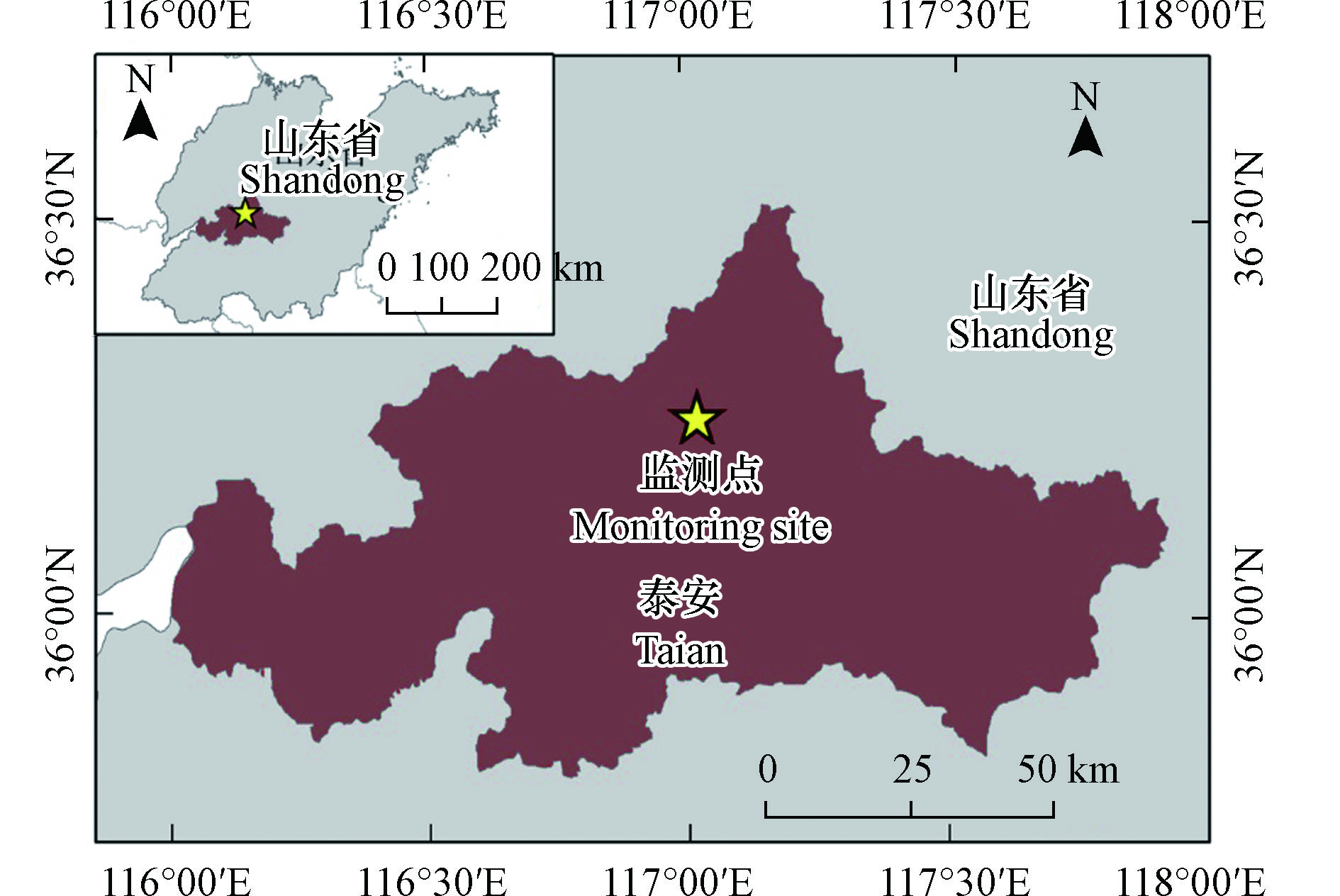
 下载:
下载:
